The firm currently has 8,000 acres (3,330 hectares) of land on the market which is higher than the same period last year, which followed a fairly restricted farmland market in 2020.
Duncan Barrie, a partner with Galbraith said: “There are a number of factors affecting the land market at present but a general economic uncertainty is usually accompanied by a resistance to selling, as people often prefer to hold on to their most tangible assets – being land and property. However, a further rise in interest rates may encourage the sale of some farms that have already been struggling to make a margin or have high levels of debt which are exposed to variable interest rates. Also in the last three years the increase in interest in land for natural capital and forestry purposes has boosted the more marginal land prices, which again may in turn encourage some landowners to sell. The potential for further changes within the economy do however make it difficult to predict the market for the rest of the year but overall we expect supply to remain tight and prices in general to hold up well over the summer with some areas of the country likely to achieve premium outcome due to lack of farms on the market.”
In the past 12 months Galbraith sold over 20,000 acres of land and estates, valued at £150m.
The firm reports that prices for premium arable land reached well in excess £15,000 per acre in some parts of the country. Land values for marginal land have in some areas of the country increased more than five-fold in the last 3 years largely driven by interest from forestry and natural capital buyers, however in recent months interest in land for afforestation has stabilised as investors are now far more selective and placing greater focus on examining any wider environmental and wildlife restrictions connected to land, before a deal has been agreed.
Scottish government policy in the agricultural sector is aligned with reducing carbon emissions and improving soil health where possible.
Duncan Barrie continued: “The unveiling of the Agricultural Reform Programme by the Scottish government this year has offered greater clarity for landowners and farmers, including specific measures that will attract funding and help reduce carbon emissions. Going forward landowners should be in a good position to access suitable funding and take advantage of emerging opportunities while assessing other areas of their business that could offer potential for greater efficiencies.”
Galbraith staff will be on hand to discuss farming, land management and rural business opportunities in the Galbraith marquee on Avenue O at the Royal Highland Show.

